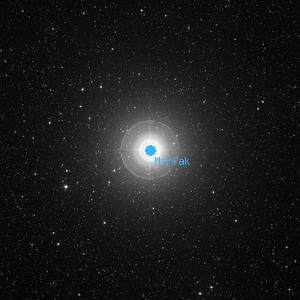Mirfak

Overlaid DSS image of Mirfak, 60' x 60' with north at top and west to the right
Aladin viewer for the region around Mirfak
Hinaliʻi , Alpha Persei, α Per, 33 Per
BD+49 917, HD 20902, HR 1017, WDS J03243+4952, SAO 38787, GSC 03320-02808, HIP 15863
BD+49 917, HD 20902, HR 1017, WDS J03243+4952, SAO 38787, GSC 03320-02808, HIP 15863
| Type | Star |
|---|---|
| Magnitude | 1.79 | Right Ascension | 3h 24' 19.4" (2000) |
| Declination | 49° 51' 40" N |
| Constellation | Perseus |
| Classification | F5Ib |
Observing Notes
Captain William Henry Smyth
Aug 22, 1837 No. 6 The Crescent, Bedford, England (map)
150mm f/17.6 refractor by Tully 1827
A standard Greenwich star, with a companion, in a rich galaxy field. A 2½, brilliant lilac; B 9, cinereous: they are followed at a little distance by many small stars.
It is now placed in the Hero's left side, but as it was called Mirfak, the elbow, or more fully Al mirfak al thureyyá, the elbow of the Pleiades, to distinguish it from the other elbow, the figure may have once been differently situated: still its other Oriental name, Jenb Bersháwush, signifies the side of Perseus (Bersháwush Περσαονs), the p being lost in Arabic. Chrysococca calls it Πλενρá Περσáορs, and it must be from the word Jenb that it was corrupted to Algenib, the style and title of γ Pegasi, an equivoque complained of by Sir J. Herschel.
A fancied line projected from the Pole-star to the Pleiades, passes through the left knee of Perseus, and points in the mid-distance to Mirfak; which is also gained by a line from Castor to Capella onwards; or by that which the rhymester points out:A ray from Algol to the PoleThe following quantity of proper motion through space has, on reference to epochal observations, been assigned to Mirfak :
with accuracy guide,
Near, but behind it, Mirfak shines
in Perseus' manly side.P.... RA -0".21 Dec. -0".02Perseus, whose mythological story is too well known to require repetition, is one of the old 48 asterisms, and is placed in a very brilliant part of the Via Lactea, nearly opposite to the three stars forming the tail of Ursa Major, on the other side of the pole, and directly north of the Pleiades.
B.... +0".11 -0".04
A.... +0".07 -0".05
[Hipparcos +0".02375 -0".02623]
In the ancient MS. of Cicero's Aratus, in the British Museum, the drawings of which as my late friend, Mr. W. G. Ottley, went far to prove, were executed before the age of Constantine, Perseus is represented with no other drapery than a light scarf, holding the head of Medusa in his left hand, and a singular hooked and pointed weapon in the right. The number of his stars may really be called infinite, on gazing with a powerful telescope; but of his constituents, whose mean apparent places are tabulated, the numbers run:Ptolemy . . . 29 stars Hevelius . . . . 46 starsThis asterism, in the Arabo-Latin Almagest, is designated Cheleab, which Grotius refers to kelb, a dog, but others to kullúb, the harpago, or hooked weapon in the Hero's hand*. It was also called Hámil rás-al-ghúl, the bearer of the demon's head, or, as the Germans say, Träger des Medusenkopfs: but it was the Caco-dæmon of astrologers. Such was its style and title for many ages; but in the new uranography of Schickard, the ethnic Perseus cum capite Medusae was supplanted by David with the head of Goliath, as had been proposed by Novidius.
Tycho Brahe . . 33 Flamsteed . . . 59
Bayer . . . . 38 Bode . . . . 196
*Some of our crusaders must have imported this word; for it is assuredly a better etymon for "club," than the clwppa and kluppel cited by Dr. Johnson.― A Cycle of Celestial Objects Vol II, The Bedford Catalogue, William Henry Smyth, 1844
Other Data Sources for Mirfak
Nearby objects for Mirfak
10 objects found within 120'
| 29 Persei | 31 Persei | 34 Persei |
| Alpha Persei Moving Cluster | HD 20809 | HD 21071 |
| HD 21278 | HD 21362 | |
| Sigma Persei |
Credits...
Drawings, descriptions, and CCD photos are copyright Andrew Cooper unless otherwise noted, no usage without permission.
A complete list of credits and sources can be found on the about page
Mirfak